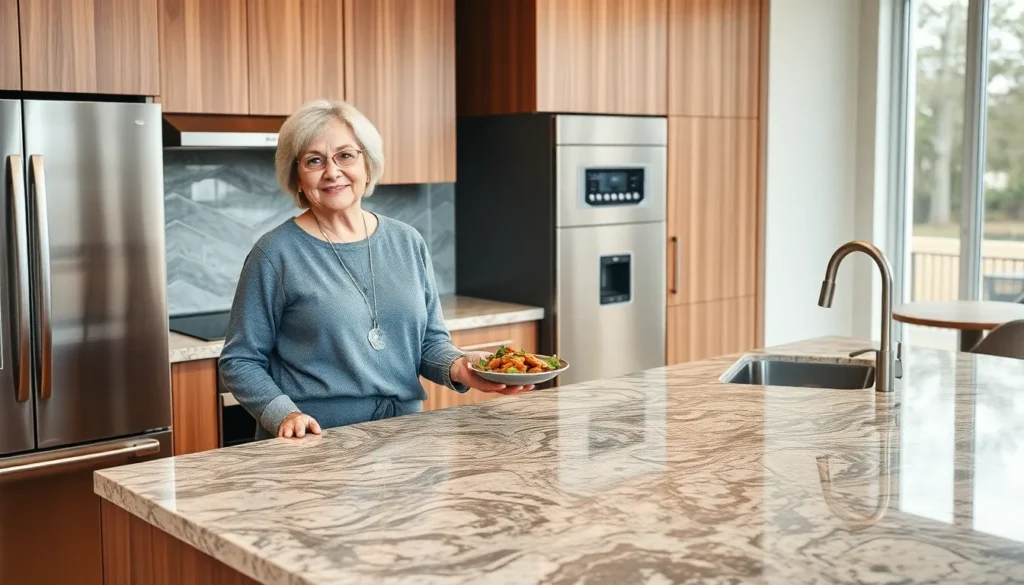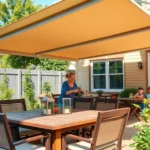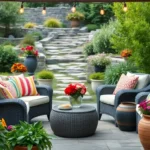We’ve all stood in our kitchens dreaming of the perfect countertops that would transform our space from ordinary to extraordinary. The right counter surface doesn’t just provide workspace – it becomes the centerpiece that defines your kitchen’s entire aesthetic and functionality.
Whether you’re planning a complete kitchen renovation or simply want to upgrade your existing counters, the choices can feel overwhelming. From classic granite and marble to innovative quartz and sustainable bamboo options, today’s market offers endless possibilities to match every style and budget.
We’ll explore the most popular kitchen counter materials, their pros and cons, and help you discover which option best suits your lifestyle and design vision. Get ready to transform your kitchen into the heart of your home with countertops that perfectly blend beauty, durability, and practicality.
Natural Stone Countertops: Timeless Elegance for Any Kitchen
Natural stone countertops offer unmatched beauty and character that synthetic materials simply cannot replicate. We’ve found that these surfaces bring authentic texture and unique patterns that make each kitchen truly one of a kind.
Granite Kitchen Counter Ideas for Durability
Granite countertops deliver exceptional strength that withstands daily kitchen demands for decades. We recommend this igneous rock for busy households since it resists scratches, heat damage, and stains when properly sealed. Popular granite varieties include Kashmir White with its subtle veining, Uba Tuba’s deep green speckles, and Baltic Brown’s rich chocolate tones.
Maintenance becomes straightforward with annual sealing to preserve granite’s natural resistance properties. Professional installation ensures proper support for granite’s substantial weight, typically requiring reinforced cabinets. Colors range from dramatic blacks like Absolute Black to warm beiges such as Giallo Ornamental, offering options for every design style.
Cost considerations place granite in the mid to upper price range at $40 to $100 per square foot installed. We’ve observed that granite’s durability often justifies this investment through increased home value and longevity.
Marble Surfaces for Luxurious Appeal
Marble countertops create sophisticated kitchen spaces with their distinctive veining and smooth finish. We particularly admire Carrara marble’s classic gray veining and Calacatta’s bold, dramatic patterns that serve as natural artwork. This metamorphic stone has graced luxury kitchens and palaces for centuries.
Porosity requires careful consideration since marble absorbs liquids and acids more readily than granite. Daily cleaning with pH neutral products prevents etching from citrus juices and wine. Regular sealing every 6 to 12 months maintains marble’s pristine appearance and reduces staining risks.
Design versatility allows marble to complement both traditional and contemporary kitchen styles. Popular choices include Statuario’s striking white background with gold veining and Emperador’s rich brown tones. Installation costs typically range from $50 to $150 per square foot depending on the marble variety and complexity.
Quartzite Options for Natural Beauty
Quartzite combines granite’s durability with marble’s elegant appearance in this naturally occurring metamorphic stone. We appreciate how quartzite offers superior hardness ratings while maintaining the organic patterns that make natural stone so appealing. Popular varieties include Super White with subtle veining and Taj Mahal’s warm cream background.
Heat resistance surpasses most countertop materials, allowing hot pots and pans without damage concerns. Quartzite requires minimal maintenance compared to marble since its dense composition naturally resists staining and etching. Sealing once or twice yearly preserves the stone’s natural beauty and enhances its protective qualities.
Color options span from Arctic White’s pristine appearance to Fantasy Brown’s dramatic swirling patterns. Installation typically costs between $50 to $120 per square foot, positioning quartzite as a premium natural stone option. We’ve noticed increasing popularity among homeowners seeking low maintenance luxury in their kitchen designs.
Engineered Quartz Solutions: Low-Maintenance Kitchen Counter Ideas
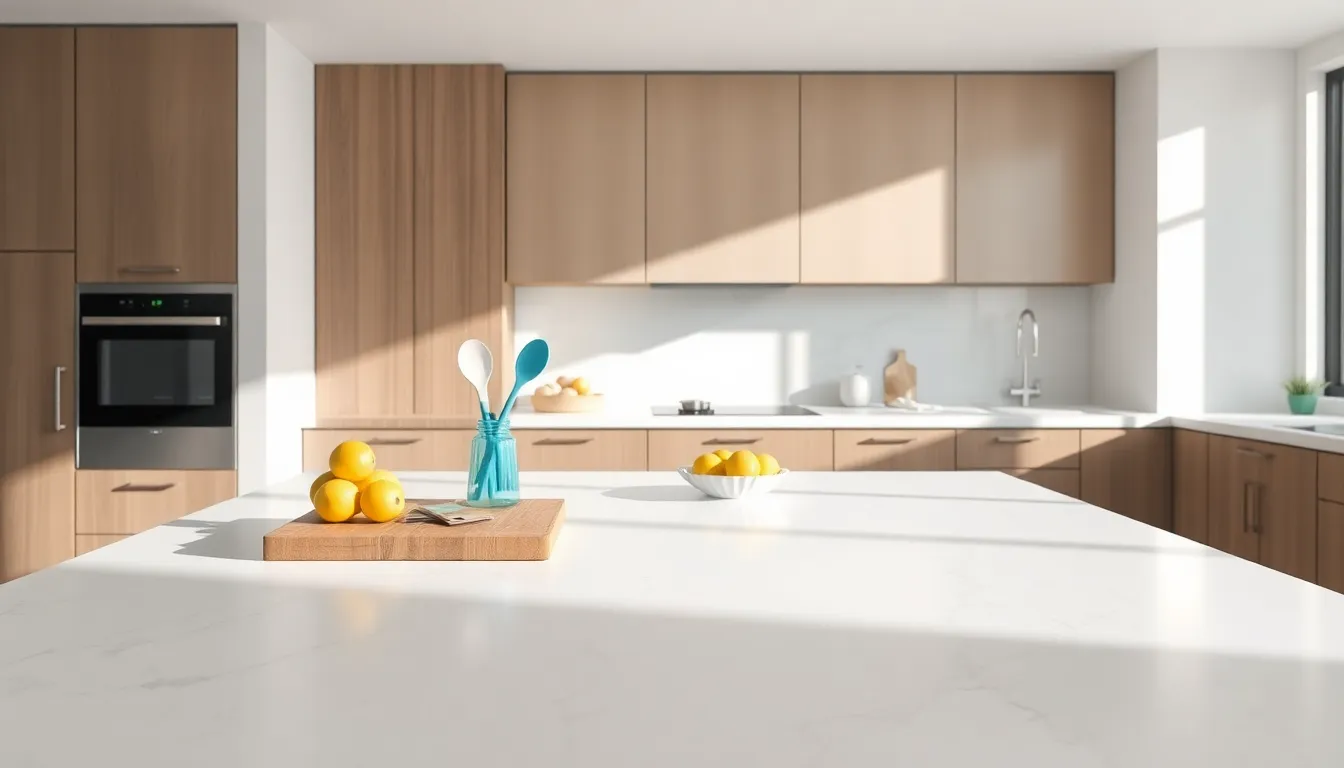
Engineered quartz countertops combine natural quartz crystals with resin to create a non-porous surface that resists cracking, chipping, etching, and scratching. We find these surfaces particularly appealing because they don’t require sealing like natural stones and can be cleaned with just a damp cloth and mild soap.
Popular Quartz Brands and Patterns
Caesarstone leads the engineered quartz market with innovative designs that mimic natural stone patterns while maintaining consistent appearance across slabs. Silestone offers extensive collections featuring classic stone-like veining and flecked designs that work beautifully in both contemporary and traditional kitchens. Cambria provides premium options with bold patterns and subtle textures that create seamless looks across large surfaces. MSI rounds out the top manufacturers with uniform colors and sophisticated veining patterns perfect for open-concept kitchen designs.
Pattern consistency across slabs ensures we can achieve flawless installations without worrying about natural stone variations. Stone-like veining patterns replicate marble’s elegance while offering superior durability for high-traffic kitchen environments. Flecked designs add visual interest and depth to solid color backgrounds, creating ever-changing surfaces that complement various cabinet styles. Uniform colors provide clean, modern aesthetics that work especially well in minimalist kitchen designs.
Color Variations for Modern Kitchens
Crisp whites with subtle veining create timeless marble-look surfaces that brighten any kitchen space while maintaining sophisticated appeal. Neutral grays offer versatile backgrounds that pair beautifully with both warm wood tones and cool stainless steel appliances. Deep blues make bold statements as accent surfaces or full countertop installations in contemporary kitchen designs. Rich blacks provide dramatic contrast against light cabinetry while hiding daily wear better than lighter alternatives.
Marble-look whites remain the most popular choice for their ability to make small kitchens appear larger and brighter. Beige and taupe options create warm, inviting atmospheres that complement traditional and transitional kitchen styles perfectly. Vibrant hues allow adventurous homeowners to incorporate personality into their kitchen designs without compromising functionality. Solid tones work exceptionally well in modern kitchens where clean lines and minimal patterns take precedence.
Heat and Stain Resistance Benefits
Acid resistance protects engineered quartz surfaces from common kitchen substances like lemon juice, vinegar, and wine that can etch natural stone. Stain resistance surpasses many natural stones, making cleanup effortless when dealing with coffee, oil, or food coloring spills. Non-porous construction prevents bacteria and mold growth, creating hygienic food preparation areas that meet health-conscious homeowners’ standards. Durability performance ensures long-term beauty in busy kitchens where daily cooking activities put surfaces to the test.
Hot pan protection requires caution since direct heat exposure can damage the resin content, though normal cooking activities rarely pose problems. Spill cleanup becomes simple maintenance tasks rather than urgent restoration needs thanks to the surface’s resistance properties. Scratch resistance helps maintain pristine appearances even with regular knife use and heavy cookware movement. Long-term performance delivers consistent beauty and functionality for decades with minimal maintenance requirements compared to natural stone alternatives.
Butcher Block and Wood Kitchen Counter Ideas

Wood countertops bring warmth and natural beauty to any kitchen while offering surprising durability when properly maintained. These surfaces are constructed from straight pieces of wood glued together, creating sturdy and durable surfaces that can withstand daily kitchen use.
Bamboo Countertops for Eco-Friendly Design
Bamboo countertops offer an environmentally conscious alternative that doesn’t compromise on style or functionality. We appreciate bamboo’s fast growth rate and low environmental impact, making it one of the most sustainable countertop materials available today.
Durability meets sustainability with bamboo’s lightweight yet robust construction that handles kitchen tasks with ease. The material resists moisture better than many traditional woods while maintaining its structural integrity over time.
Design versatility shines through bamboo’s unique grain patterns and natural color variations. This material fits seamlessly with both modern minimalist kitchens and traditional farmhouse designs, offering flexibility for various aesthetic preferences.
Installation benefits include bamboo’s lighter weight compared to stone alternatives, reducing structural requirements and installation complexity. We find that bamboo countertops cost significantly less than premium natural stone options while delivering comparable visual impact.
Reclaimed Wood for Rustic Charm
Reclaimed wood countertops deliver authentic rustic appeal that transforms kitchens into warm, inviting spaces. We love how these surfaces tell stories through their weathered textures, nail holes, and aged patina that new materials simply can’t replicate.
Sustainability advantages make reclaimed wood an environmentally responsible choice that reduces waste while supporting eco-friendly design principles. Each piece carries history from barns, warehouses, or old buildings, giving your kitchen unique character.
Customization possibilities allow us to match various kitchen styles, from industrial lofts to cozy cottages. Different wood species like oak and acacia provide distinct colors and textures, ensuring your countertop complements your exact design vision.
Cost effectiveness often makes reclaimed wood more affordable than new hardwood options while delivering superior visual interest. We recommend sourcing from reputable suppliers who properly treat and prepare the wood for kitchen use.
Maintenance Tips for Wooden Surfaces
Regular oil treatments protect wooden countertops and maintain their natural beauty throughout years of kitchen use. We recommend applying food-safe mineral oil or specialized wood conditioner every 4-6 weeks, depending on usage frequency.
Cleaning protocols require gentle soap and water instead of harsh chemicals that can damage the wood’s protective finish. Daily maintenance involves wiping spills immediately and using cutting boards to prevent knife marks and scratches.
Scratch repair becomes simple with fine-grit sandpaper and fresh oil applications that restore damaged areas to their original appearance. Minor scratches actually add character to wooden surfaces, creating a lived-in aesthetic that many homeowners desire.
Preventive measures include using trivets for hot pots and pans, since direct heat can cause discoloration or cracking. We suggest maintaining consistent humidity levels in your kitchen to prevent wood expansion and contraction that leads to gaps or warping.
Concrete Kitchen Counter Ideas for Industrial Style
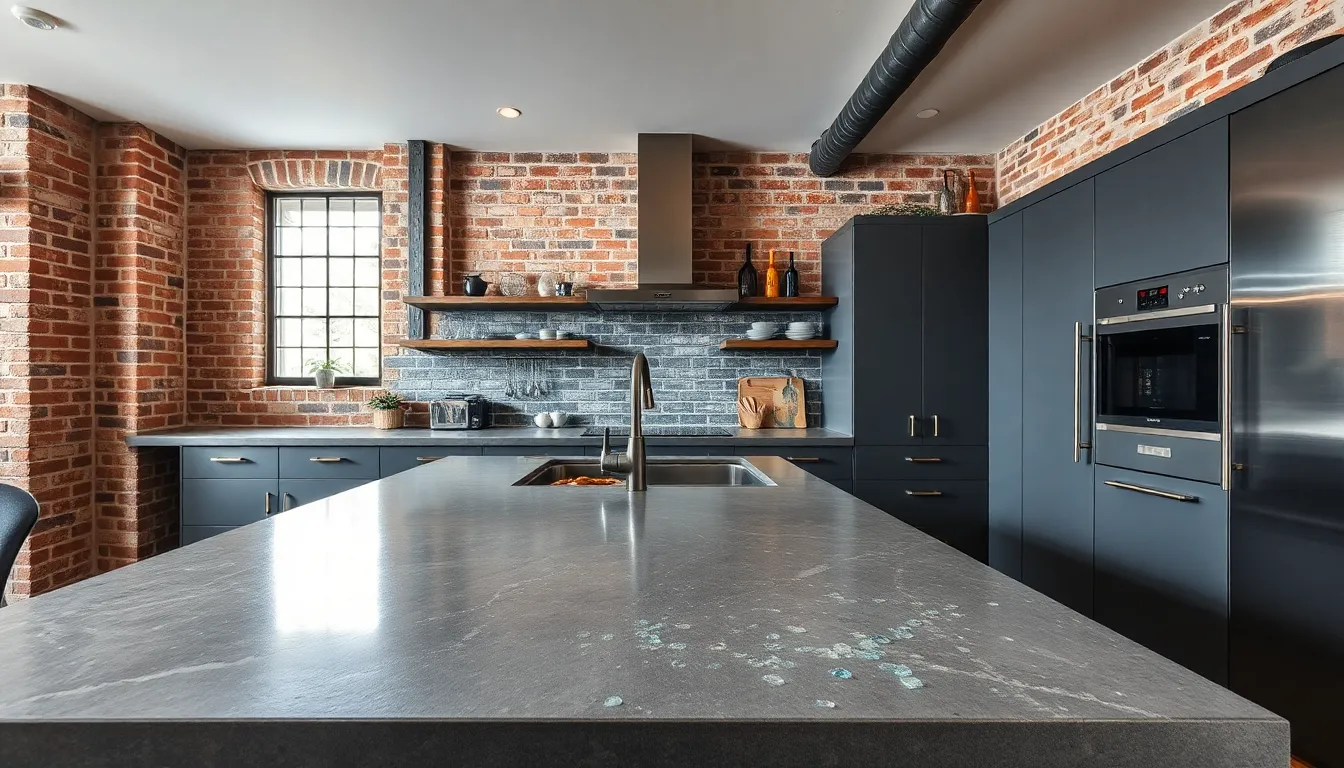
Concrete countertops deliver the raw, urban aesthetic that defines industrial kitchen design. We’ll explore how to create stunning concrete surfaces that complement exposed brick walls, metal accents, and minimalist cabinetry.
DIY Concrete Countertop Projects
Molded concrete countertops offer homeowners a budget-friendly way to achieve custom results. We recommend starting with pre-made forms that simplify the shaping process and reduce the learning curve for first-time concrete workers.
Sealing and finishing applications protect your investment while improving the surface appearance. Apply penetrating sealers within 24 hours of curing to prevent stains and moisture damage. Professional-grade topical sealers create additional protection against kitchen spills and daily wear.
Template creation allows precise measurements before mixing concrete. Cut cardboard or plywood templates that match your exact counter dimensions, including cutouts for sinks and appliances. This preparation step prevents costly mistakes during the pour.
Mixing ratios determine the final strength and workability of your concrete. Use a 1:2:3 ratio of cement, sand, and aggregate for optimal results. Add fiber reinforcement to minimize cracking and increase tensile strength.
Decorative Finishes and Textures
Polished finishes create sleek surfaces that reflect light and enhance modern industrial aesthetics. Wet polishing with diamond pads progresses through grits from 50 to 3000 for mirror-like results. This process typically takes 3-4 hours per section but delivers professional-quality shine.
Honed surfaces provide subtle texture while maintaining smoothness for food preparation. Stop the polishing process at 400-grit to achieve this sophisticated matte appearance that hides fingerprints and water spots.
Embedded materials like glass fragments, metal shavings, or stone chips add unique visual interest to concrete countertops. Mix these decorative elements into the top layer during pouring, then expose them through grinding and polishing techniques.
Acid staining transforms plain concrete into surfaces that mimic natural stone or aged metal. Apply chemical stains after initial curing to create rich earth tones, deep blues, or oxidized copper effects that complement industrial design elements.
Cost-Effective Custom Answers
Custom shapes and sizes maximize functionality without the premium costs associated with natural stone fabrication. Concrete molds easily around existing cabinetry, creating seamless integration with unusual layouts or angled corners.
Color variations expand design possibilities beyond traditional gray concrete. Integral color additives mixed during batching create consistent hues throughout the material thickness. Popular industrial colors include charcoal black, warm bronze, and deep forest green.
Integrated sink designs eliminate seams and joints that collect debris in traditional installations. Form the sink bowl simultaneously with the countertop pour for a monolithic appearance that enhances the minimalist industrial aesthetic.
Edge profiles can be customized using rubber or foam forms to create unique details. Sharp 90-degree edges emphasize geometric industrial themes, while subtle bullnose profiles soften the overall appearance for family-friendly kitchens.
Stainless Steel and Metal Kitchen Counter Ideas
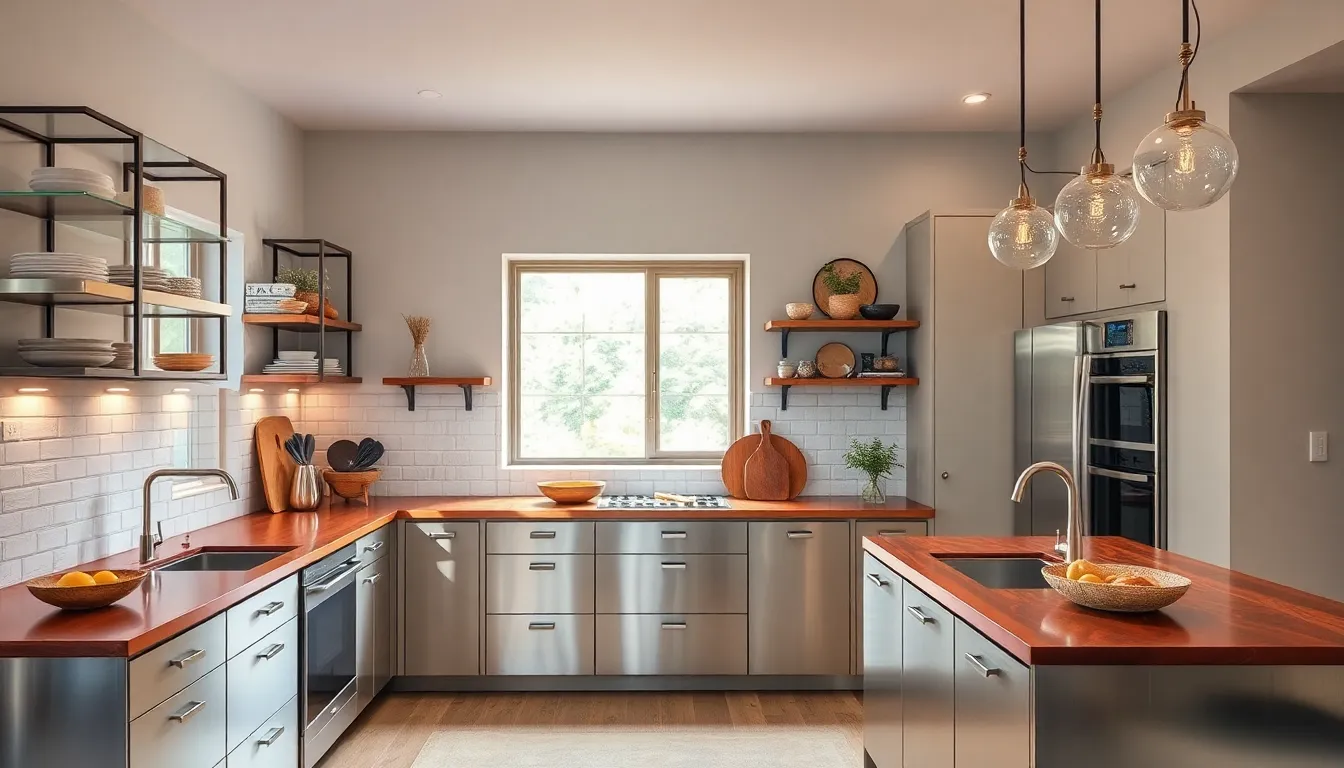
Stainless steel and metal countertops bring the efficiency and sophistication of commercial kitchens into residential spaces. These surfaces offer exceptional durability, heat resistance, and hygienic properties that make them increasingly popular among modern homeowners.
Professional Kitchen Aesthetics
Stainless steel countertops dominate professional kitchen aesthetics with their non-porous surfaces that resist bacteria and stains. We see these surfaces frequently in commercial kitchens because they withstand high temperatures and heavy use while maintaining their sleek appearance. Functionality takes precedence in this design approach, emphasizing efficiency and ergonomics throughout the workspace.
Solid surface composites and natural stone materials complement stainless steel counters in professional settings. Flush mount lighting fixtures enhance the streamlined appearance while open shelving creates a cohesive, work-oriented environment. Clean lines and minimal ornamentation define this aesthetic, prioritizing ease of maintenance and optimal workflow.
Modern residential kitchens adopt professional elements by incorporating industrial materials and layouts. Contemporary design themes pair beautifully with metal surfaces, creating spaces that feel both sophisticated and functional. Easy maintenance becomes a important advantage when busy households choose materials inspired by commercial kitchen standards.
Copper Countertops for Unique Character
Copper countertops develop a distinctive patina over time, creating surfaces with evolving beauty and historical charm. This material offers natural antibacterial properties that make it both practical and visually appealing for kitchen environments. Exposure to air and moisture transforms copper’s appearance, ensuring each installation becomes unique with age.
Vintage-inspired looks emerge naturally from copper’s warm tones and organic aging process. We recommend copper for homeowners seeking kitchen surfaces with personality and character that traditional materials can’t match. Regular sealing and gentle cleaning preserve the appearance while allowing the natural patina to develop gradually.
Maintenance requirements include protecting copper from acidic substances and applying specialized cleaners designed for metal surfaces. Heat resistance makes copper suitable for busy cooking environments, though cutting boards remain essential for food preparation. Cost considerations include both material expenses and professional installation requirements for optimal results.
Zinc Surfaces for Vintage Appeal
Zinc countertops feature soft, matte gray appearances that create lived-in, vintage aesthetics perfect for traditional and contemporary kitchens. This material develops rich patina over time, giving each surface unique character and timeless, European-inspired style. Natural aging processes enhance zinc’s visual appeal rather than diminishing its functionality.
Durability characteristics include antimicrobial properties and heat resistance that make zinc practical for everyday kitchen use. We find zinc surfaces particularly appealing because they age gracefully while maintaining their structural integrity. Traditional design elements pair beautifully with zinc’s naturally weathered appearance.
Contemporary kitchens benefit from zinc’s versatility in complementing both modern fixtures and vintage accessories. Maintenance involves gentle cleaning with pH-neutral products and occasional conditioning to preserve the surface quality. Installation typically requires professional expertise to ensure proper sealing and edge finishing for long-term performance.
Tile and Mosaic Kitchen Counter Ideas
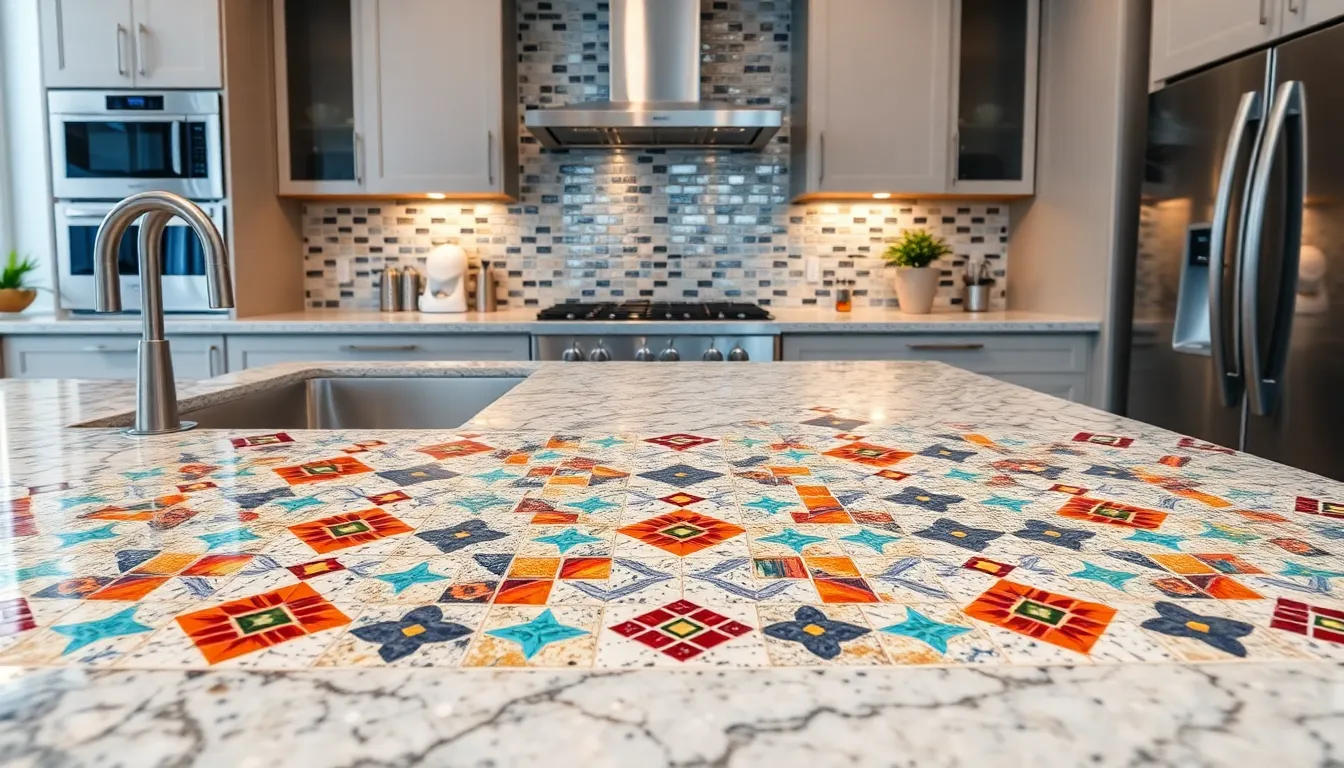
Tile and mosaic countertops offer endless design possibilities while providing durability and easy maintenance for busy kitchens. These versatile surfaces let you create custom patterns and incorporate various materials to match your unique style preferences.
Ceramic Tile Design Patterns
Herringbone patterns transform ordinary ceramic tiles into sophisticated focal points by arranging them in zigzag formations. This classic design adds visual interest and works particularly well with subway tiles or rectangular ceramic pieces.
Chevron arrangements create modern appeal through inverted V-shaped tile placements that draw the eye across the counter surface. We recommend using this pattern with neutral ceramic colors like whites and grays to maintain versatility in kitchen design.
Hexagon configurations bring geometric elegance to ceramic tile countertops through their distinctive six-sided shapes. These tiles work exceptionally well in contemporary kitchens and can be combined with contrasting grout colors to emphasize the pattern.
Grid layouts offer timeless simplicity with square ceramic tiles arranged in traditional straight lines. This pattern provides maximum flexibility for incorporating accent tiles or creating border designs around the counter perimeter.
Natural Stone Tile Applications
Marble tiles deliver luxurious sophistication with their distinctive veining patterns and elegant appearance. Carrara and Calacatta varieties remain popular choices, though they require regular sealing to prevent staining and etching from acidic substances.
Granite tiles provide exceptional durability and heat resistance, making them ideal for high-traffic kitchen areas. These tiles come in many colors and patterns, from classic blacks and grays to more dramatic options with gold veining.
Travertine surfaces create warm, earthy atmospheres perfect for Mediterranean or rustic kitchen designs. This natural stone offers unique texture variations and can be finished with either honed or polished surfaces depending on your aesthetic preferences.
Slate applications bring dramatic color depth through their rich blacks, grays, and blues that complement modern kitchen designs. These tiles resist heat damage and provide natural slip resistance, though they require proper sealing for optimal performance.
Glass Mosaic for Contemporary Looks
Colorful mosaic arrangements incorporate vibrant blues, greens, and reds to create striking focal points in contemporary kitchens. These reflective surfaces amplify natural light and can be customized to match existing color schemes or create bold contrast statements.
Geometric glass patterns use precise shapes like diamonds, triangles, and rectangles to achieve modern sophistication. We find these designs work particularly well when combined with neutral cabinetry to let the tile pattern take center stage.
Metallic finish mosaics integrate silver, gold, and copper tones that complement stainless steel appliances and modern fixtures. These specialty glass tiles add depth and luxury while maintaining the practical benefits of easy cleaning and stain resistance.
Textured glass surfaces provide dimensional interest through raised patterns, frosted finishes, or rippled textures that catch and reflect light differently. These options create visual movement across the counter surface while maintaining the sleek appearance that glass tiles are known for.
Laminate Kitchen Counter Ideas: Budget-Friendly Options

We find laminate countertops offer exceptional value for homeowners seeking style without very costly. These versatile surfaces deliver durability and easy maintenance at a fraction of the cost of natural stone options.
Modern Laminate Patterns and Textures
Modern laminate countertops feature an impressive array of patterns and textures that can transform any kitchen space. Today’s manufacturers create surfaces that convincingly mimic natural materials like wood grain, stone veining, and leather finishes. Geometric patterns add contemporary flair, while subtle textures provide visual depth without overwhelming the design.
Popular texture options include matte finishes that reduce fingerprints and glare, brushed surfaces that hide minor scratches, and high gloss alternatives that reflect light to brighten darker kitchens. We love how these varied textures allow homeowners to achieve their desired aesthetic while maintaining budget consciousness.
Combining laminate countertops with glass front cabinets and stainless steel appliances creates a fresh, modern kitchen atmosphere. Color coordination becomes effortless when you select patterns that complement existing cabinetry and hardware finishes.
Stone-Look Laminate Alternatives
Stone look laminate alternatives deliver luxury aesthetics without the premium price tag or intensive maintenance requirements. Granite effect patterns capture the natural beauty of speckled stone surfaces, featuring realistic color variations and depth that fool even discerning eyes. These options provide the visual impact of real granite while eliminating concerns about sealing, staining, and cracking.
Marble inspired designs showcase elegant veining patterns in classic white, dramatic black, and sophisticated gray colorways. We appreciate how these surfaces maintain their pristine appearance without the porousness issues associated with natural marble. Travertine and slate looks add earthy sophistication to kitchen designs seeking organic warmth.
Quartz appearance laminates combine the best of both worlds, offering consistent patterns with subtle sparkle effects. These alternatives cost significantly less than engineered quartz while providing similar visual appeal and easier installation processes.
Installation and Replacement Tips
Installation simplicity makes laminate countertops accessible for both professional contractors and ambitious DIY enthusiasts. Professional installation ensures smooth, even finishes that maximize longevity and visual appeal. We recommend hiring experienced installers for complex layouts involving multiple seams or specialty cuts around sinks and appliances.
Existing laminate surfaces can be refreshed through various update methods without complete replacement. Painting techniques using specialized countertop paint create entirely new looks in weekend timeframes. Epoxy coating applications add depth and durability while mimicking expensive stone appearances.
Contact paper overlays provide temporary answers for renters or homeowners planning future renovations. These peel and stick options come in hundreds of patterns and require minimal tools for application. We suggest thorough surface preparation and careful measurement to achieve professional looking results with any DIY approach.
Mixed Material Kitchen Counter Ideas for Creative Design

Creating visual interest in your kitchen becomes effortless when you combine different countertop materials. Mixed material designs allow you to maximize both form and function while expressing your personal style.
Combining Different Textures
Natural stone and engineered materials create striking contrasts that enhance your kitchen’s visual appeal. We recommend pairing rough granite surfaces with smooth quartz sections to establish distinct work zones. Concrete countertops paired with warm butcher block sections deliver an industrial-meets-organic aesthetic that’s both modern and inviting.
Marble and butcher block combinations offer the perfect balance of elegance and practicality. Position marble near your baking station where you’ll appreciate its cool surface for pastry work, while butcher block serves as your primary prep area. This pairing creates distinct functional zones while maintaining design cohesion.
Granite and quartz pairings maximize durability across your entire kitchen workspace. Use granite’s natural beauty for your main counters and incorporate quartz’s low-maintenance properties in high-traffic areas. Stainless steel accents alongside marble-like quartz surfaces add professional touches that elevate your kitchen’s modern appeal.
Island vs. Perimeter Counter Variations
Kitchen islands provide excellent opportunities to introduce contrasting materials without overwhelming your design. We suggest using butcher block on your island while maintaining marble-like quartz on perimeter counters for a balanced approach. Islands naturally serve as focal points, making them ideal candidates for bolder material choices.
Functionality drives successful material selection when planning island variations. Choose materials that complement your island’s primary purpose—food prep areas benefit from butcher block warmth, while entertaining spaces shine with elegant marble surfaces. Perimeter counters can maintain consistency while your island becomes a statement piece.
Visual weight balancing ensures your mixed materials feel intentional rather than scattered. Darker materials on your island create grounding effects, while lighter perimeter surfaces maintain an open, airy atmosphere throughout your kitchen space.
Accent Strips and Inlays
Accent strips enhance design cohesion by connecting different countertop materials throughout your kitchen. We recommend incorporating thin strips of contrasting materials at transitions between different surfaces. These details create seamless connections while highlighting the unique properties of each material choice.
Personalized inlay elements allow you to incorporate favorite accent colors from your linens, fixtures, or decorative accessories. Metal inlays in copper or brass add warmth to stone surfaces, while glass strips provide contemporary touches that reflect light beautifully. These creative expressions transform functional surfaces into artistic statements.
Color coordination through inlays ties together your entire kitchen design scheme. Choose accent materials that echo cabinet hardware finishes, backsplash elements, or appliance details for a cohesive appearance that feels professionally designed.
Color and Pattern Kitchen Counter Ideas
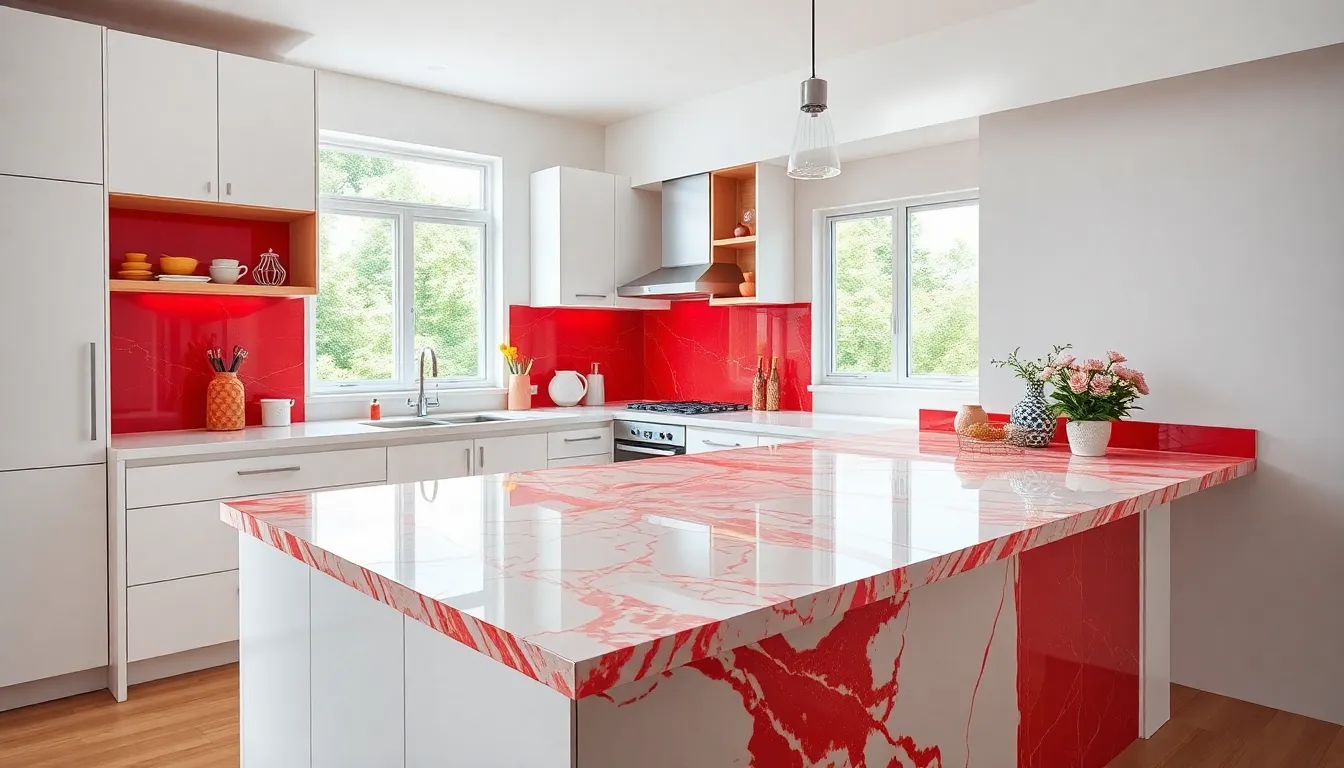
After exploring various countertop materials and their unique properties, we turn our attention to the visual elements that truly make your kitchen stand out. Color and pattern choices can transform any countertop material into a stunning focal point that reflects your personal style.
Bold Statement Colors
Bold statement colors create dramatic focal points that energize your entire kitchen space. Materials like laminate or solid surface countertops can be custom colored to match vibrant hues, allowing you to achieve exactly the look you want. A bold red countertop paired with white cabinets creates a striking contrast that commands attention, while a deep blue surface adds sophistication and depth to modern kitchen designs.
Bright colors work exceptionally well when balanced with neutral elements throughout the space. We recommend using bold countertops as accent pieces rather than covering every surface, which prevents overwhelming the room. Custom colored quartz and solid surface materials offer the most flexibility for achieving these statement looks while maintaining durability and functionality.
Neutral Tones for Versatility
Neutral tones such as white, gray, or beige provide timeless appeal that complements virtually any kitchen style. These versatile options enhance resale value by appealing to a broader range of potential buyers, making them smart long term investments. White countertops brighten spaces and create clean, fresh aesthetics that never go out of style.
Gray tones offer sophisticated elegance while hiding minor scratches and stains better than pure white surfaces. Beige and cream colors provide warmth without being too bold, creating cozy atmospheres that feel welcoming. We find that neutral countertops allow you to experiment with colorful backsplashes, cabinet hardware, and decorative accessories without clashing.
These classic colors pair beautifully with both light and dark cabinetry, giving you flexibility to update other kitchen elements over time. Natural materials like marble and granite naturally occur in these neutral palettes, while engineered options can be manufactured to achieve consistent neutral tones throughout large installations.
Veining and Pattern Considerations
Natural materials like marble, granite, and quartzite offer unique veining patterns that add visual interest and character to kitchen spaces. Each slab features distinct patterns created by geological processes, ensuring your countertops will be truly one of a kind. Marble veining ranges from subtle whispers of color to bold, dramatic streaks that become artistic statements.
Granite patterns vary from tight, consistent speckles to sweeping movements of color and mineral deposits. We suggest viewing full slabs before making final decisions, as patterns can vary significantly even within the same stone type. Quartzite combines the best of both worlds, offering marble like veining with granite like durability.
Pattern direction affects how veining flows across your countertops, especially around sinks and cooktops where seams may be necessary. Bookmatched slabs create mirror image patterns that enhance symmetry, while continuous veining creates flowing movements across larger surfaces. The choice of veining pattern depends on your personal preference and the desired style of your kitchen, whether you prefer subtle elegance or bold artistic expression.
Small Kitchen Counter Ideas for Space Optimization
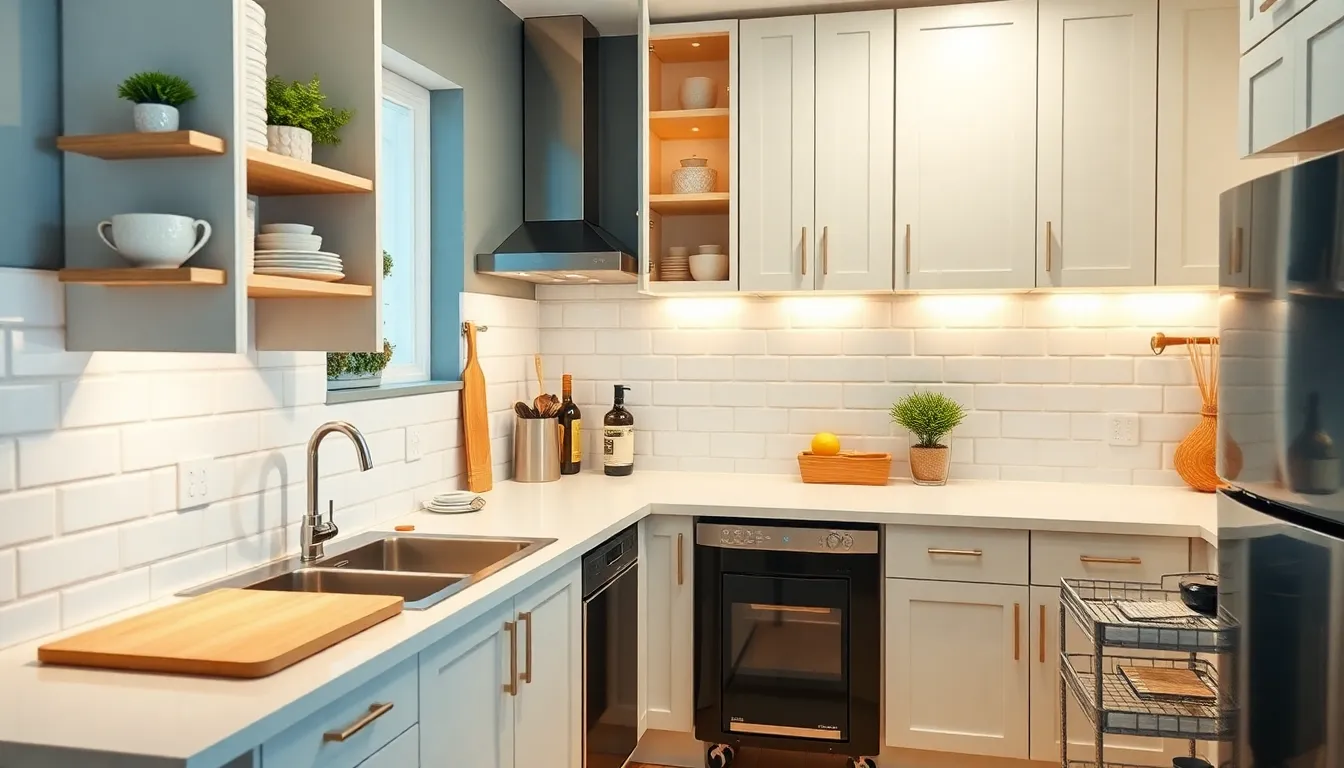
Maximizing limited counter space requires strategic answers that transform every inch into functional workspace. We’ll explore innovative approaches that create more room without expanding your kitchen’s footprint.
Compact Counter Answers
Over-the-sink cutting boards transform your sink area into valuable prep space while keeping the rest of your counters clear. Installing a sturdy cutting board that spans your sink creates an instant workspace for food preparation without requiring additional counter real estate.
In-sink drying racks eliminate counter clutter by utilizing the sink basin for dish drying. Collapsible models expand when needed and fold away for full sink access, keeping your limited counter space free for cooking tasks.
Rolling carts provide mobile counter extensions that move wherever you need extra workspace. Choose models with butcher block tops or stainless steel surfaces that complement your existing counters while offering storage underneath.
Wall-mounted drop leaf tables attach directly to your wall and fold down when not in use. These space-saving answers create temporary counter space for meal prep or casual dining without permanently occupying floor space.
Multi-Level Counter Designs
Tiered counter systems maximize vertical space by creating multiple work surfaces at different heights. Installing a raised section behind your main counter provides additional prep area while maintaining clear sight lines across your kitchen.
Bar-height counters combine workspace with casual dining opportunities by extending your counter upward. This dual-purpose design creates functional zones that serve both cooking and eating needs without requiring separate furniture.
Stepped countertops use corner spaces effectively by creating graduated levels that follow your kitchen’s natural flow. Each tier provides dedicated space for exact tasks while maintaining visual continuity throughout the design.
Island counter variations incorporate different heights on a single surface to accommodate various kitchen activities. Lower sections work perfectly for pastry preparation while standard heights handle everyday cooking tasks.
Fold-Down and Expandable Options
Fold-down countertops attach to walls with heavy-duty hinges and fold flat when not needed. These installations provide substantial workspace for cooking projects while disappearing completely to preserve walking space.
Expandable countertops use sliding mechanisms or pull-out sections to increase surface area on demand. Hidden extensions tuck beneath your existing counter and slide out to double your workspace when preparing large meals.
Retractable cutting boards slide out from designated slots in your cabinetry to create instant prep surfaces. These built-in answers keep knives and cutting tools organized while providing clean workspace exactly where you need it.
Flip-up breakfast bars transform narrow counter extensions into dining surfaces with simple rotating mechanisms. When folded down, they maintain your kitchen’s streamlined appearance while offering seating options when raised.
Conclusion
Choosing the perfect kitchen countertop doesn’t have to be overwhelming when you understand your options. We’ve explored everything from timeless natural stone to innovative engineered materials and budget-friendly alternatives that deliver both style and functionality.
Your ideal countertop depends on your lifestyle cooking habits budget and design vision. Whether you’re drawn to granite’s durability marble’s elegance or the practicality of engineered quartz there’s a solution that fits your needs perfectly.
Remember that successful kitchen design often combines multiple materials and creative space-saving answers. Don’t be afraid to mix textures experiment with colors or incorporate unique patterns that reflect your personal style.
The key is balancing aesthetics with practicality to create a kitchen that works beautifully for years to come.
Frequently Asked Questions
What are the most popular kitchen countertop materials?
The most popular kitchen countertop materials include natural stone options like granite, marble, and quartzite, engineered quartz, wood-based surfaces like butcher block and bamboo, concrete, stainless steel, tile and mosaic, and laminate. Each material offers unique benefits in terms of durability, aesthetics, maintenance requirements, and cost, allowing homeowners to choose based on their lifestyle and design preferences.
How do I choose between granite and marble countertops?
Choose granite for exceptional durability and low maintenance, making it ideal for busy households with heavy kitchen use. Granite resists scratches, heat, and stains better than marble. Select marble for luxurious aesthetics and distinctive veining patterns, but be prepared for higher maintenance needs due to its porous nature. Marble requires regular sealing and careful handling of acidic substances.
Are engineered quartz countertops worth the investment?
Yes, engineered quartz countertops offer excellent value through their non-porous surface that resists cracking, chipping, etching, and scratching. They require minimal maintenance without sealing, provide consistent patterns, and offer heat and stain resistance. Popular brands like Caesarstone and Silestone deliver innovative designs perfect for modern kitchens, making them a practical long-term investment.
What are the benefits of wood countertops like butcher block?
Wood countertops bring natural warmth and character to kitchens while offering durability and design versatility. Butcher block provides an excellent cutting surface, while bamboo offers eco-friendly sustainability and moisture resistance. Wood surfaces can be customized and refinished over time. However, they require regular oil treatments and gentle cleaning protocols to maintain their appearance and prevent damage.
How much maintenance do concrete countertops require?
Concrete countertops require moderate maintenance including regular sealing to protect against stains and moisture. They need gentle cleaning with non-abrasive products and occasional resealing depending on usage. While durable and customizable with unique finishes and integrated features, concrete surfaces can develop hairline cracks over time and require professional repair for significant damage.
Are stainless steel countertops suitable for home kitchens?
Yes, stainless steel countertops bring commercial kitchen efficiency to residential spaces with excellent durability, heat resistance, and hygienic properties. They’re ideal for serious home cooks who prioritize functionality and easy cleaning. However, they can show fingerprints and scratches more easily than other materials and may create a cold, industrial aesthetic that doesn’t suit all design preferences.
What’s the difference between ceramic and natural stone tiles for countertops?
Ceramic tiles offer consistent patterns, easy maintenance, and budget-friendly installation with endless design possibilities including herringbone and hexagon layouts. Natural stone tiles like marble and granite provide unique character with natural variations, superior durability, and luxurious aesthetics. However, natural stone requires more maintenance including sealing and careful cleaning to prevent staining and etching.
Can laminate countertops look like natural stone?
Modern laminate technology creates convincing replicas of natural materials including stone veining, wood grain textures, and granite patterns. High-quality laminates offer matte and high-gloss finishes that closely mimic expensive materials at a fraction of the cost. While not identical to natural stone, today’s laminates provide excellent aesthetics, easy maintenance, and budget-friendly installation for homeowners seeking luxury looks.
How can I maximize counter space in a small kitchen?
Maximize small kitchen counter space with compact solutions like over-the-sink cutting boards, mobile rolling carts, and in-sink drying racks. Consider multi-level designs with tiered systems and bar-height counters to create functional zones. Install fold-down cutting boards, retractable surfaces, and flip-up breakfast bars that expand workspace when needed while maintaining the kitchen’s compact footprint.
What colors and patterns work best for kitchen countertops?
Choose neutral tones like white, gray, and beige for timeless appeal and enhanced resale value, allowing colorful accents elsewhere. Bold statement colors like vibrant reds or deep blues create stunning focal points when balanced with neutral elements. Natural materials offer unique veining patterns that add character, with considerations for pattern direction and symmetry to achieve cohesive design throughout the kitchen space.

